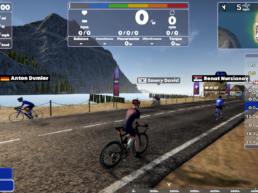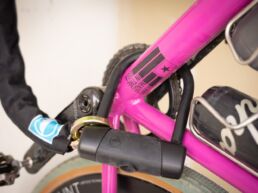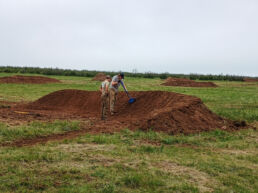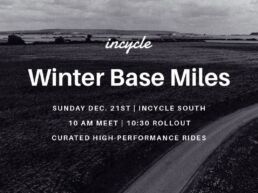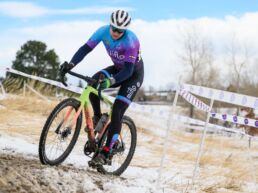
On June 10th, Joshua Krabbe of 1st City Cycling finished 2nd in the 5th annual Gold Rush Gravel Grinder Mother Lode: 210 Mile Adventure. Interestingly, this 200 mile race would mark his 100th and 101st century rides. Joshua completed the course in and around the Black Hills of South Dakota in 12hr 38min and had 13k feet of climbing. He was roughly 30min behind 1st and 15min ahead of 3rd. Read our interview with Joshua about his preparation and his race below.
Joshua’s Instagram play by play
https://www.instagram.com/jdkrabbe/
1 > I thought you were going to do the 110 mile race?
Depends when you talked to me. Around Christmas if you asked me I would have told you I was going to try the big one, I then had a rather garbage year of nordic skiing (consistency wise, the days were good when I went) and when the cycling season came around this spring I was in pretty poor shape, aerobically speaking, compared with previous years. Once I finally got any semblance of consistency into my training this spring it seemed way too ambitious to get ready for a 12+ hour race effort in time so I had kinda changed plans and was set on doing the 110 course like lots of the others from our team.
2 > What changed your mind back?
I had a really great day out in early May with a bunch of teammates, we rode Pennock and then north towards RedFeather. Various groups did some variations but Harmon and I rode 9 hours and I was feeling really strong in the last 2 hours. That was a confidence boost. It was enough of a vote of confidence in myself that I then decided to try a ~4.5 hour TT on memorial day weekend and rode up Trail Ridge Road from town. I basically wanted to check on my fat burning capacity, whether or not I was effectively burning fat at endurance pace or I was just getting by based on digested carbs. To keep up a pace that was worthy of a “race” for 12+ hours I knew that I needed to be in good fat burning shape *and* be able to keep digesting fuel the whole way too. There’s nowhere to hide when you’re going uphill and it’s a good way to know whether or not your body’s metabolism can supply the energy needs that your heart and lungs can burn through or not, that’s why I chose to basically climb for the whole TT. I of course was breathing like crazy once up at altitude and felt completely out of breath, but my energy supply was good. Basically those two rides told me I had got the metabolism aspect of my fitness ready “enough” for 12-15 hours.
3 > That’s it? Two training rides and you’re ready for 200+ miles?
Endurance fitness comes from overall training load more than from the duration of any single ride, so basically yes, that was enough. I did a race-simulation effort the week prior with a few teammates. Basically I just sat on the top of zone 2 for a bit more than 3 hours to make sure I knew what it *should* feel like. That wasn’t so much physiological training as it was psychological practice, I only finally signed up for the big kahuna after I got home from that one.
4 > I can believe some of the fitness aspect, but doesn’t your body need to also do the really big rides to be ready?
Yes, I think there’s some durability to be built up in the muscles by doing long days, but those do also wear you down. A handful of them was enough.
5 > And how about sitting on a bike seat for that long? What shorts did you wear?
I raced in my team-issue San Remo skinsuit from Castelli. I’m very happy with it. The cut is low on the back of my neck so I need to make sure to be sunscreened there but fit and comfort wise that kit is perfect.
6 > And applied chamois butter every five minutes?
I have tried various chamois creams over the years and now generally ride/race without. The key to no issues is prevention, on any single ride I don’t think chamois lubricant makes a big difference, but I don’t pretend this is an answer for everyone. I do carry Burts-Bees lipbalm which is basically just a mix of beeswax and coconut oil as a lubricant for chafing or hotspots, but the team kit this year is pretty solid and I didn’t have any issues.
7 > OK, and the bike you were riding? Is it gravel grinding specific?
Santa Cruz Stigmata. Ibis 928 wheels. Same as I ran for SSCX last year but I have gears on it now, I bought it with the intention that it could dual purpose and it has done so without any issues. Hydro SRAM Force 11-28 and 38×48 front rings. Compact drop alloy bars. I’m running a seat that I bought at RioSwap for $10 because the shape of the nose looked good for flying mounts, it turns out I really like it. If I can figure out what it is I should try and find another one and put it on my road bike.
8 > And Tires?
I have 40mm Clement MSOs on there right now, setup tubeless with Stans. I run them pretty hard, 45-50 psi, but you have to remember I am 200 lbs so my PSI doesn’t translate to your average cyclist. Even if you discount the tyre PSI to a more normal weight, I do like to run a bit harder than people recommend.
9 > Are MSOs what you’d recommend for gravel grinding?
Hmm. not sure if I recommend them. They are really fast on hardpacked and softpacked dirt and gravel and they corner confidently on generally every surface but I had some really lousy experiences with them when racing a very wet race earlier in May (the weekend of that huge snowstorm) and they behaved like plows in the sloppy mud. The tread on the rear has also worn down quicker than I would expect. It’s not like I haven’t put on the miles, but I think I went through it faster than I deem fiscally appropriate. They’re not an all-rounder, but for this event they were appropriate for the conditions and did well. I will likely keep an MSO on the front for the rest of the gravel grinding season and seek something else for the rear. I prefer to have an all-rounder setup than swap tyres based on conditions even though I realize that is potentially a better strategy.
10 > Camelbak or no camelbak? How did you carry enough water?
I raced all my gravel races last year with a camelbak and didn’t like it. I hate how the mouth thing always drips. I have tried a million versions, they all drip. Anyone who tells me otherwise is probably trying to sell me something. Who likes to ride a bike with their left nipple always wet because of a dribbly camelbak? That’s not my idea of a good time. I got a frame bag after Bite the Bullet Fondo last year to try and remedy that situation. Because I ride an extra large frame I can run bottles below it, and then I just put two water bottles with locking tops loose inside it, I can swap them down to the cages as need be. It’s a fine system. I tried putting a camelbak bladder in the frame bag but the hose routing makes that a pain to refill, and it just relocates the dribbly spout issue, it doesn’t solve it.
11 > Just water?
I started with a spoonful of brown sugar and water mixed in 2 water bottles and one bottle of heed which is basically just maltodextrin. I then switched to Nuun tabs in water for the rest of the day and got my calories from food. I wouldn’t have minded to get some coke out there but I had no way to keep my drop-bags cold, and I didn’t want hot coke. I chose a Nuun version that has 40 mg of caffeine which is a bit more caffeine than a can of coke, but I mixed them into a bottle that is bigger than a can of coke, so that’s quite a bit of caffeine but it’s not going to give you a heart attack either.
12 > So you had drop bags of your own supplies instead of aid stations?
Yes and No. There was a combination. There were five designated places along the course where you could get water and three of them you could send a bag of supplies to. The others were just water and a check-in. You were allowed to have a support crew meet you at the stops if you wanted, but all my friends were racing other races (as they should be) so I just had my supply bags.
13 > Tell me about your fueling plan for the big day? What was in your drop bags?
I didn’t do a whole lot different than I do on any 5+ hour long ride, except perhaps eating a bit more. I have done enough long rides that I have a pretty good idea of what I like. That means some relatively complex carbs, some sources of fat and some sources of protein and I dose in simple carbs when the intensity is going to be higher or I am mentally suffering, generally that means eating sugar in the 20 minutes prior to bigger climbs or late into rides when my endurance is being stretched. Generally I knew we’d probably start with a higher intensity than I’d average all day and hence the brown sugar in the bottles to start and I ate three bananas in the first 90 minutes, which are relatively simple carbs, especially if they’re really ripe (aka brown). Greener bananas digest a bit slower but the soft ones are pretty simple sugar. I had macadamia nuts which are quite high in fat, peanuts, a bit of beef jerky, and a tube of sunflower seeds if you’re wondering how you get protein and fat out on a bike without worrying about the mayonnaise on your tuna sandwich going funny. I didn’t need 4 things, but I wanted to be able to present myself with options to eat what seemed palatable. The macadamia nuts were the winner and I ate all of them from all of my drop bags. For carbs after the bananas were gone I had lara bars, powerbars, some dark chocolate, and then a whole lot of jellybeans in the last 75 miles, like 1200 calories of jellybeans. Some jellybeans have sucrose in them not just HFCS and so you get the multiple absorption paths thing working to your advantage, your intestine can move more calories of a glucose and fructose mix than it can move of just one or the other. I don’t know if those details matter all that much at this sort of power output, but the science is out there and if you can stack the deck to your advantage by reading the ingredients list on the bag of jellybeans then by all means it’s worth trying. I had cans of pringles in my drop bags because I have had good experience with pringles late into some really long days, but they didn’t do very well for me this weekend and I probably only ate ten.
14 > The course wasn’t marked, you didn’t get lost anywhere in 210 miles?
Last year a bunch of my teammates got lost on course and I attribute that to the cue sheets having a lot of extraneous information on them. It was hard to know which instructions were important and which ones were basic FYI tidbits of info. This year they were edited down for clarity and I really think the race directors did a good job finding a balance of mentioning unimportant side-roads when they were confusing but leaving them off the sheets when they were only likely to be a distraction. The list of turns was probably only 40% as long as last year despite the same course.
15 > That still doesn’t stop you from getting lost, there is some effort involved in staying on course is there not?
I probably spent 2 hours reviewing the maps on google-satellite and reviewing other athlete’s strava recordings of the route in previous years. I highlighted on my map what was going to be climbing and what was going to be descending. I think just the act of doing that helped me to feel “oriented” in places I had never been. It also helped to know by looking at my map if I would be descending for a while, and therefore should make sure I ate something significant to digest while the HR was going to be a few BPM lower for a period of time, vs eating 300+ calories of nuts at the bottom of a steep hill because I didn’t know it was coming.
16 > So, you clearly had nutrition tactics, did you have much for race tactics or did you approach it like an unreasonably long TT?
I knew that I could probably ride with the lead group and so even though there were some skinny guys pushing the pace on some of the very early short hills I did what it took to keep up. I didn’t want to get split right at the beginning just because I was being a stubborn arse and staying within some power or HR cap. That meant that early on there were some big efforts, but that paid off because I was in a group of 6 for the first 2 hours in Sand Creek canyon where the grade was flat or only ~1% and drafting made a difference. After that I got split at Aid1 and the subsequent climb and it was solo TT from there. I caught and passed 3 after that, but I was going much faster than each of them by the time I caught them and no real opportunities for cooperation presented themselves. Of course, some of the steep hills and looser dirt portions were higher intensity, but basically I just did a long slow burn. Everything was based on feel. I have power recorded but I didn’t look at it. It wouldn’t do good things for my head. There’s no way you’re going to look at power numbers on a 12 hour ride and think that they are “good” while you’re doing them. It would have just been a recipe to go too hard probably from hour 3 to hour 6 or 7, when I just know I would have been comparing to my TT effort up Trail Ridge. This isn’t some sort of monk like discipline not to look at power while riding, I basically never look that’s my habit, I just ride and look afterward.
17 > So what was the power data?
I averaged 194 W (coasting zeros in) and the hardest hour was near the start at 249 W. FTP is somewhere around 340 maybe a bit higher, so it’s pretty obvious that this was not a high intensity ride. I didn’t do any 5min portions above FTP, but when I was getting split on a climb at around 2 hours into the day it was close, 5min peak power was 339 there. Retrospectively, I was able to tell that the effort was going into the red and I just refused to do it. Refused enough that I let myself get dropped.
18 > 194 W average doesn’t really communicate the overall demand though, or does it?
Well 194 W for 12+ hours is hard to do. My 42-day CTL had just got to 8000 kJ/week prior to the race and the race was 8600 kJ. So, I did a bit more than a week worth of work in a single ride. 8000 kJ/week correlates to about 12.5 hours of riding for me. My biggest weeks this year have only been 15 hours so the real key is that I have had a pretty solid block since easter. Normally there’s a bigger gap between a peak week and your CTL, it’s probably also a good indication I’m due for some rest.
19 > Next race?
I am signed up for Gravel Worlds in Lincoln Nebraska in mid-August and will likely do the Lander 131 Gravel Grinder in mid-September up in Wyoming.
20 > Not Bite the Bullet?
No, I loved that course and the race/fondo dynamic was really good, but I have family stuff planned that weekend, a bit of a bike tour with my Dad. We’re going to do some gravel roads around Crested Butte. Hopefully it’s an OK lead-in to Gravel Worlds, maybe unconventional, but I don’t think it’s likely to screw me up.
Joshua’s Instagram play by play
https://www.instagram.com/jdkrabbe/

